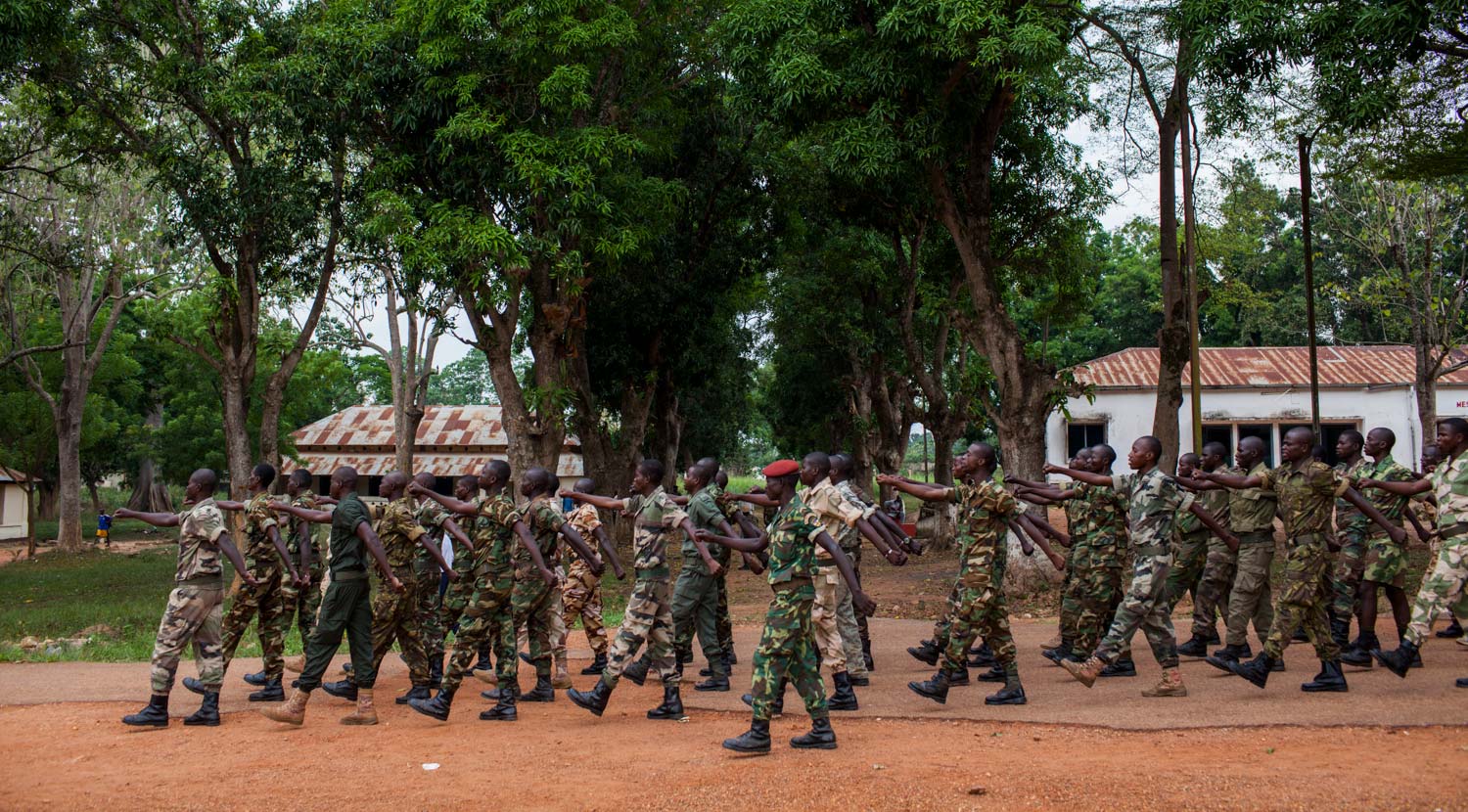
Methodology: Risk Factor Sources
Data We Use to Generate Our Statistical Risk Assessment
Our Statistical Risk Assessment relies on publicly available data that describe various characteristics of each country. Our statistical modeling only considers factors for which we have reliable measures covering nearly all countries of the world for many years. Because mass killing is rare, global data spanning decades are necessary to identify patterns.
We currently use 38 variables from about a dozen data sources. Below is a list of the data, and their sources, that go into our statistical model, grouped into five categories: basic country characteristics, war and conflict, human rights and civil liberties, governance, and socioeconomic characteristics. For more information on data transformations, download our Data Dictionary. All source data are available on GitHub.
Photo above: A patrol and Anti-Balaka roadblock takedown with Rwandan African Union soldiers, in Bangui, CAR. USHMM/Michael Christopher Brown, 2014.
Basic Country Characteristics
Infant Mortality Rate
- Source: United Nations World Population Prospects 2024 | Transformed by EWP
New Country
- Indicates country is in its first, second, or third year since independence
- Early Warning Project, based on Skrede Gleditsch’s list of independent states
Number of Years Since Independence
Population Size
- Source: World Bank World Development Indicators (SP.POP.TOTL); Maddison Project (pop) | Transformed by EWP
Region
- Africa, Americas, East Asia and the Pacific, Europe, Middle East and North Africa, South and Central Asia (Note: We code region as a set of dummy variables with Africa as the reference region. Thus, countries in Africa will be coded as zero on each of the five region variables.)
- Source: US Department of State
War and Conflict
Any Coup Attempts In Past Five Years
Any Mass Killing (since 1945)
- Has the country (or its predecessor) experienced a mass killing onset since 1945?
- Source: Early Warning Project
Average Annual Rate of Mass Killing Onsets
- Source: Early Warning Project
Battle-Related Deaths
- Source: Peace Research Institute Oslo (PRIO); Uppsala Conflict Data Program | Transformed by EWP
Government Censorship
- Does the government directly or indirectly attempt to censor the print or broadcast media?
- Source: Varieties of Democracy (V-DEM) (v2mecenefm_ord) | Transformed by EWP
Mass Killing Onset in 2022
- Was there a mass killing onset in this country in 2022?
- Source: Early Warning Project
Number of Ongoing Mass Killings
- Source: Early Warning Project
Ongoing Mass Killing(s) Targets Multiple or Broad Groups
- Does any ongoing mass killing in the state target multiple groups (ethnic, racial, national, or religious) or a broadly defined group (e.g., political opponents)?
- Source: Early Warning Project
Ongoing Mass Killing(s) Targets Exactly One Protected Group
- Do all ongoing mass killings in the state each only target exactly one ethnic, racial, national, or religious group?
- Source: Early Warning Project
Prevention of Women’s Participation in Civil Society Organizations
- Source: Varieties of Democracy (V-DEM) (v2csgender_ord) | Transformed by EWP
Human Rights and Civil Liberties
Civil Society Repression
- Does the government attempt to repress civil society organizations (CSOs)?
- Source: Varieties of Democracy (V-DEM) (v2csreprss_ord) | Transformed by EWP
Freedom of Discussion
- Are citizens able to openly discuss political issues in private homes and in public spaces?
- Source: Varieties of Democracy (V-DEM) (v2xcl_disc)
Freedom of Religion
- Is there freedom of religion?
- Source: Varieties of Democracy (V-DEM) (v2clrelig_ord)
Government Censorship
- Does the government directly or indirectly attempt to censor the print or broadcast media?
- Source: Varieties of Democracy (V-DEM) (v2mecenefm) | Transformed by EWP
Inequality in Civil Liberties — Geographic Region
- Is government respect (or lack of respect) for civil liberties equal across different geographic areas of the country?
- Source: Varieties of Democracy (V-DEM) (v2clrgunev_ord) | Transformed by EWP
Inequality in Civil Liberties — Social Group
- Do some social groups—as distinguished by language, ethnicity, religion, race, region, or caste—have fewer civil liberties than others?
- Source: Varieties of Democracy (V-DEM) (v2clsocgrp_ord) | Transformed by EWP
Percentage of Population Discriminated Against
- The percentage of the population that is coded as being discriminated against.
- Source: Ethnic Power Relations (EPR) Dataset
Political Killing
- Do political killings occur? Political killings are killings by the state or its agents without due process of law for the purpose of eliminating political opponents. These killings are the result of deliberate use of lethal force by the police, security forces, prison officials, or other agents of the state (including paramilitary groups).
- Source: Varieties of Democracy (V-DEM) (v2clkill_ord) | Transformed by EWP
Prevention of Women's Participation in Civil Society Organizations
- Source: Varieties of Democracy (V-DEM) (v2csgender) | Transformed by EWP
State Signatory of First Optional Protocol to the International Covenant on Civil and Political Rights
- Source: Ulfelder’s Country Memberships in Selected Intergovernmental Organizations and Accession to Selected Regional and Global Treaty Regimes; Office of the United Nations High Commissioner for Human Rights
Governance
Judicial Reform
- Were the judiciary’s formal powers altered this year in ways that affect its ability to control the arbitrary use of state authority?
- Source: Varieties of Democracy (V-DEM) (v2jureform_ord)
Minority Control
- Does a minority control political rule?
- Source: Varieties of Democracy (V-DEM) (v2pepwrsoc_ord) | Transformed by EWP
Party Ban
- Are any parties banned?
- Source: Varieties of Democracy (V-DEM) (v2psparban_ord) | Transformed by EWP
Power Distributed by Social Group
- Is political power distributed according to social groups?
- Source: Varieties of Democracy (V-DEM) (v2pepwrsoc_ord) | Transformed by EWP
Power Distributed by Socioeconomic Position
- Is political power distributed according to socioeconomic position?
- Source: Varieties of Democracy (V-DEM) (v2pepwrses)
Socioeconomic
Annual Percentage Change in GDP Per Capita
- Source: World Bank World Development Indicators (NY.GDP.MKTP.KD.ZG); Maddison Project (gdppc)
Ethnic Fractionalization
- A measure of ethnic heterogeneity
- Source: Historical Index of Ethnic Fractionalization (HIEF) Dataset (efindex); UCLA Anderson School of Management's Ethnic Fractionalization Data (Alesina. et al. 2003)

